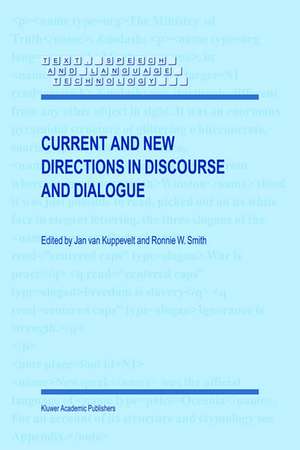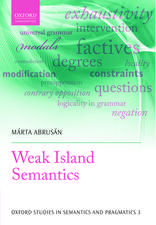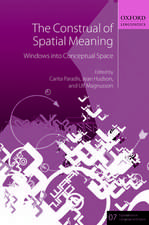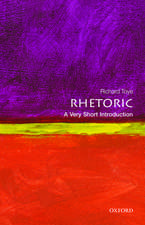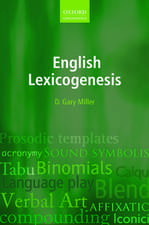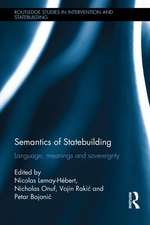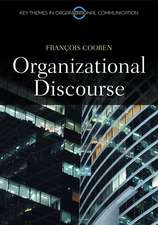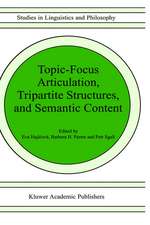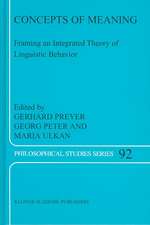Current and New Directions in Discourse and Dialogue: Text, Speech and Language Technology, cartea 22
Editat de Jan C.J. van Kuppevelt, R.W. Smithen Limba Engleză Hardback – 30 noi 2003
| Toate formatele și edițiile | Preț | Express |
|---|---|---|
| Paperback (1) | 954.62 lei 6-8 săpt. | |
| SPRINGER NETHERLANDS – 30 noi 2003 | 954.62 lei 6-8 săpt. | |
| Hardback (1) | 955.56 lei 6-8 săpt. | |
| SPRINGER NETHERLANDS – 30 noi 2003 | 955.56 lei 6-8 săpt. |
Din seria Text, Speech and Language Technology
-
 Preț: 391.79 lei
Preț: 391.79 lei - 20%
 Preț: 652.54 lei
Preț: 652.54 lei - 18%
 Preț: 954.14 lei
Preț: 954.14 lei - 18%
 Preț: 952.89 lei
Preț: 952.89 lei - 18%
 Preț: 945.30 lei
Preț: 945.30 lei - 18%
 Preț: 1222.94 lei
Preț: 1222.94 lei - 18%
 Preț: 954.31 lei
Preț: 954.31 lei - 18%
 Preț: 949.73 lei
Preț: 949.73 lei - 15%
 Preț: 640.06 lei
Preț: 640.06 lei - 15%
 Preț: 646.94 lei
Preț: 646.94 lei - 18%
 Preț: 949.37 lei
Preț: 949.37 lei - 20%
 Preț: 651.89 lei
Preț: 651.89 lei - 15%
 Preț: 644.30 lei
Preț: 644.30 lei - 18%
 Preț: 961.55 lei
Preț: 961.55 lei - 20%
 Preț: 1006.12 lei
Preț: 1006.12 lei - 20%
 Preț: 993.09 lei
Preț: 993.09 lei - 15%
 Preț: 642.51 lei
Preț: 642.51 lei -
 Preț: 389.49 lei
Preț: 389.49 lei - 20%
 Preț: 643.17 lei
Preț: 643.17 lei - 18%
 Preț: 947.50 lei
Preț: 947.50 lei - 20%
 Preț: 993.93 lei
Preț: 993.93 lei - 18%
 Preț: 953.03 lei
Preț: 953.03 lei - 18%
 Preț: 951.91 lei
Preț: 951.91 lei - 15%
 Preț: 645.14 lei
Preț: 645.14 lei - 18%
 Preț: 953.97 lei
Preț: 953.97 lei
Preț: 955.56 lei
Preț vechi: 1165.32 lei
-18% Nou
Puncte Express: 1433
Preț estimativ în valută:
182.87€ • 198.57$ • 153.61£
182.87€ • 198.57$ • 153.61£
Carte tipărită la comandă
Livrare economică 22 aprilie-06 mai
Preluare comenzi: 021 569.72.76
Specificații
ISBN-13: 9781402016141
ISBN-10: 140201614X
Pagini: 398
Ilustrații: XII, 381 p.
Dimensiuni: 155 x 235 x 27 mm
Greutate: 0.74 kg
Ediția:2003
Editura: SPRINGER NETHERLANDS
Colecția Springer
Seria Text, Speech and Language Technology
Locul publicării:Dordrecht, Netherlands
ISBN-10: 140201614X
Pagini: 398
Ilustrații: XII, 381 p.
Dimensiuni: 155 x 235 x 27 mm
Greutate: 0.74 kg
Ediția:2003
Editura: SPRINGER NETHERLANDS
Colecția Springer
Seria Text, Speech and Language Technology
Locul publicării:Dordrecht, Netherlands
Public țintă
ResearchCuprins
1 Annotations and Tools for an Activity Based Spoken Language Corpus.- 1. Introduction.- 2. GSLC and Other Goteborg Corpora.- 3. Storage.- 4. Description of the Corpus Transcription Standard.- 5. Tools Which Have Been Developed.- 6. Types of Quantitative Analysis.- 7. Types of Qualitative Analysis.- 8. Conclusions and Future Directions.- References.- 2 Using Direct Variant Transduction for Rapid Development of Natural Spoken Interfaces.- 1. Introduction.- 2. Characteristics of Direct Variant Transduction.- 3. Constructing an Application with Example-Action Contexts.- 4. Context Expansion.- 5. Recognition, Classification and Matching.- 6. Dialog Control and Confirmation.- 7. Experiments.- 8. Concluding Remarks.- References.- 3 An Interface for Annotating Natural Interactivity.- 1. Introduction.- 2. Today’s Natural Interactivity Coding Tools.- 3. The Nite Project.- 4. Nite Target User Groups.- 5. General Tool Requirements.- 6. Annotation User Interface Requirements.- 7. The Audio-Visual Annotation Interface.- 8. Conclusion and Future Work.- Acknowledgements.- References.- 4 Managing Communicative Intentions with Collaborative Problem Solving.- 1. Previous Work.- 2. A Collaborative Problem-Solving Model.- 3. Examples.- 4. Use in Dialogue Systems.- 5. Conclusions and Future Work.- References.- 5 Building a Discourse-Tagged Corpus in the Framework of Rhetorical Structure Theory.- 1. Introduction.- 2. Framework.- 3. Discourse Annotation Task.- 4. Quality Assurance.- 5. Corpus Overview.- 6. Mining the RST Corpus.- 7. Conclusions and Future Work.- Acknowledgements.- References.- 6 An Empirical Study of Speech Recognition Errors in Human Computer Dialogue.- 1. Introduction.- 2. The Speech Recognition Component.- 3. Integrated Parsing of User Utterances.- 4. The DialogueProcess.- 5. From Speech Recognition Errors to Speech Act Recognition Errors.- 6. Evaluating Robustness to Speech Recognition Errors.- 7. Conclusion.- Acknowledgements.- References.- 7 Comparing Several Aspects of Human-Computer and Human-Human Dialogues.- 1. Introduction.- 2. Our Data.- 3. Analysis.- 4. Analysis of Misunderstandings.- 5. Discussion.- 6. Conclusions.- Appendix: Dialogue Act Tag Set and Examples.- References.- 8 Full Paraphrase Generation for Fragments in Dialogue.- 1. Introduction.- 2. SHARDS.- 3. Generation of Fragment Paraphrases.- 4. An Implemented System for Fragment Resolution and Paraphrase Generation.- 5. Conclusion and Future Research.- Acknowledgements.- References.- 9 Disentangling Public from non-Public Meaning.- 1. Introduction.- 2. Utterer’s Content v. Utterer’s Plan.- 3. Clarifying Utterer’s Content.- 4. Whymeta: an analysis.- 5. Concluding Remarks.- References.- 10 Adaptivity and Response Generation in a Spoken Dialogue System.- 1. Introduction.- 2. Interaction Management.- 3. Dialogue Response Generation.- 4. Confidence-based Adaptivity.- 5. Conclusion.- References.- 11 On the Means for Clarification in Dialogue.- 1. Introduction.- 2. Clarification Forms.- 3. Clarification Readings.- 4. Corpus Analysis.- 5. Conclusions.- Acknowledgements.- Appendix: Corpus Markup Decision Trees.- References.- 12 Plug and Play Spoken Dialogue Processing.- 1. Introduction.- 2. The CANTONA Plug and Play Demonstrator.- 3. Device Descriptions: Rules and Hierarchies.- 4. Plug and Play Response Generation.- 5. Plug and Play Speech Recognition and Parsing.- 6. Discussion.- Acknowledgements.- References.- 13 Conversational Implicatures and Communication Theory.- 1. Introduction.- 2. Particularized Conversational Implicatures.- 3. Generalized ConversationalImplicatures.- References.- 14 Reconciling Control and Discourse Structure.- 1. Introduction.- 2. Discourse Structure and Control Analysis.- 3. Relationship between Control and Discourse Structure.- 4. Reconciling Control inside Discourse Segments.- 5. Conclusion.- 6. Future Work.- Acknowledgements.- References.- 15 The Information State Approach to Dialogue Management.- 1. Introduction.- 2. The Information State Approach.- 3. A Multi-level Architecture for Reusable Dialogue Management.- 4. TrindiKit: A Dialogue Move Engine Toolkit.- 5. Implementations using TrindiKit.- 6. Reusing Dialogue Management Components.- References.- 16 Visualizing Spoken Discourse.- 1. Introduction: Interruptions and Dialogue.- 2. Research Goals and Procedures.- 3. Prosodie Characteristics of Interruptions.- 4. Implications for Dialogue Systems.- 5. Conclusion.- Acknowledgements.- References.
